Jim Poling Sr.'s Blog, page 56
August 28, 2011
A Deadly Seduction
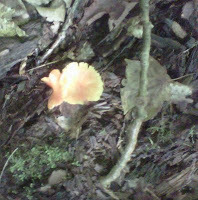 It's the time of year when the mushrooms start calling to you. They stand on the forest floor, perhaps with a shaft of sunlight illuminating them, and they whisper seductively how delicious they are. This year is another banner mushroom year, likely because of the ample rains. The autumn mushrooms are popping up in a variety of wild colours: jet black, bright orange, earth-coloured shades.I don't listen to their calls anymore. Too dangerous. Ask Nicholas Evans, author of The Horse Whisperer, the popular novel that was turned into a movie starring Robert Redford and Kristin Scott Thomas. Three years ago he went mushroom picking in the Scottish Highlands. He found some along the edge of a pine forest, cooked them in butter and parsley, and served them to his wife, brother-in-law and his wife. Their lives changed dramatically after that meal.His wife and brother-in-law are still on dialysis and waiting for kidney transplants. Evans received a new kidney recently from his adult daughter.Evans was no stranger to mushrooms and had been picking them since he was a boy. But something went wrong that day. He picked some that were similar to an edible type he knows but they almost killed all four them.
It's the time of year when the mushrooms start calling to you. They stand on the forest floor, perhaps with a shaft of sunlight illuminating them, and they whisper seductively how delicious they are. This year is another banner mushroom year, likely because of the ample rains. The autumn mushrooms are popping up in a variety of wild colours: jet black, bright orange, earth-coloured shades.I don't listen to their calls anymore. Too dangerous. Ask Nicholas Evans, author of The Horse Whisperer, the popular novel that was turned into a movie starring Robert Redford and Kristin Scott Thomas. Three years ago he went mushroom picking in the Scottish Highlands. He found some along the edge of a pine forest, cooked them in butter and parsley, and served them to his wife, brother-in-law and his wife. Their lives changed dramatically after that meal.His wife and brother-in-law are still on dialysis and waiting for kidney transplants. Evans received a new kidney recently from his adult daughter.Evans was no stranger to mushrooms and had been picking them since he was a boy. But something went wrong that day. He picked some that were similar to an edible type he knows but they almost killed all four them.
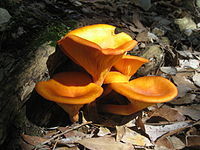 Mushroom misidentification and poisoning are not uncommon. Some time back a doctor wrote how he followed a mushroom picking guidebook and ended up in a New York hospital after becoming poisoned. Never believe any of those folk tales about how to tell good mushrooms from deadly ones. It is not true that brightly-coloured mushrooms are the deadly ones. You cannot safely test mushrooms by boiling them with a piece of silver that turns black from poison. Silver does not react to mushrooms of any kind. One of the greatest dangers is that mushrooms that are edible in one geographic location, might not be in another. If you are going picking, make sure you know what you are doing.
Mushroom misidentification and poisoning are not uncommon. Some time back a doctor wrote how he followed a mushroom picking guidebook and ended up in a New York hospital after becoming poisoned. Never believe any of those folk tales about how to tell good mushrooms from deadly ones. It is not true that brightly-coloured mushrooms are the deadly ones. You cannot safely test mushrooms by boiling them with a piece of silver that turns black from poison. Silver does not react to mushrooms of any kind. One of the greatest dangers is that mushrooms that are edible in one geographic location, might not be in another. If you are going picking, make sure you know what you are doing.
Published on August 28, 2011 08:10
August 21, 2011
Kids and Caterpillars: Be Careful
Most of the kids who visit our cottage want to hunt and catch bugs. They love caterpillars because many are fuzzy and cuddly and easy to catch and keep around. You hate to ruin their fun but it's important to be vigilant about which caterpillars they pick up as playmates.
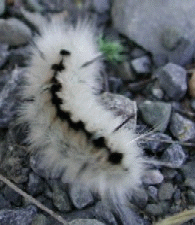
Hickory Tussock Moth Caterpillar
Caterpillars, of course, turn into moths or butterflies. Some hairy caterpillars carry venom in their stiff hairs or "spines" as a means of defence. When they are touched, the hairs can break, releasing the venom. There are several or more of the stinging variety, including the hickory Tussock moth caterpillar found from Nova Scotia through Ontario.
In most cases, the venom causes stinging or burning and little else. Some people are more sensitive to the stings than others and might get a rash, or in severe cases, swelling and nausea.
Some hairy caterpillars have venom that is extremely dangerous but none of these are found in Canada.
Also, if you ever wondered why caterpillars are so slinky, it's because a caterpillar has 2,000 muscles in its body. The human body has 700.
For more on venomous caterpillars try these sites:
http://www.uky.edu/Ag/Entomology/entf...


Hickory Tussock Moth Caterpillar
Caterpillars, of course, turn into moths or butterflies. Some hairy caterpillars carry venom in their stiff hairs or "spines" as a means of defence. When they are touched, the hairs can break, releasing the venom. There are several or more of the stinging variety, including the hickory Tussock moth caterpillar found from Nova Scotia through Ontario.
In most cases, the venom causes stinging or burning and little else. Some people are more sensitive to the stings than others and might get a rash, or in severe cases, swelling and nausea.
Some hairy caterpillars have venom that is extremely dangerous but none of these are found in Canada.
Also, if you ever wondered why caterpillars are so slinky, it's because a caterpillar has 2,000 muscles in its body. The human body has 700.
For more on venomous caterpillars try these sites:
http://www.uky.edu/Ag/Entomology/entf...
Published on August 21, 2011 19:36
August 16, 2011
Policing for Revenue?
There is a line between enforcing the law in the interest of public safety and enforcing it to raise revenue. Police forces, directed by their political masters, are crossing that line more often in these rough economic times.
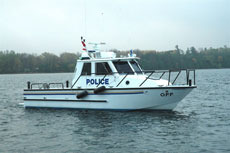 The Ontario Provincial Police have been on our lake at least four times this summer checking boats for alcohol, required equipment such as a working flashlight and those absurd boating licences. Normally they show up once a year to remind everyone they are out and about promoting safety.You can hear the provincial coffers ringing as they go about the lake issuing tickets. They boarded one fellow's boat and found an empty glass that smelled of alcohol although there was no alcohol on the boat. They gave him a breathalyser test, which he passed. However, the empty glass that smelled of alcohol was enough for them to charge him, which will cost him $300 or more.There are more and more cases like this where a warning would suffice. But the province needs money and policing is an important revenue stream. Law enforcement officers will tell you they are not pressured to lay charges. However, woe be the officer whose ticket issuing is below average at performance review time.The story making the rounds in cottage country is that the OPP had to buy more boats for patrols during last summer's G8 meeting in Huntsville. Now they are using the boats to raise money to pay for them. One priority of the OPP's strategic plan is to "build trusting relationships with the public . . . ." A trusting relationship will be built only if the public believes that law enforcement's main focus is public safety, free of pressure to raise revenues.
The Ontario Provincial Police have been on our lake at least four times this summer checking boats for alcohol, required equipment such as a working flashlight and those absurd boating licences. Normally they show up once a year to remind everyone they are out and about promoting safety.You can hear the provincial coffers ringing as they go about the lake issuing tickets. They boarded one fellow's boat and found an empty glass that smelled of alcohol although there was no alcohol on the boat. They gave him a breathalyser test, which he passed. However, the empty glass that smelled of alcohol was enough for them to charge him, which will cost him $300 or more.There are more and more cases like this where a warning would suffice. But the province needs money and policing is an important revenue stream. Law enforcement officers will tell you they are not pressured to lay charges. However, woe be the officer whose ticket issuing is below average at performance review time.The story making the rounds in cottage country is that the OPP had to buy more boats for patrols during last summer's G8 meeting in Huntsville. Now they are using the boats to raise money to pay for them. One priority of the OPP's strategic plan is to "build trusting relationships with the public . . . ." A trusting relationship will be built only if the public believes that law enforcement's main focus is public safety, free of pressure to raise revenues.

 The Ontario Provincial Police have been on our lake at least four times this summer checking boats for alcohol, required equipment such as a working flashlight and those absurd boating licences. Normally they show up once a year to remind everyone they are out and about promoting safety.You can hear the provincial coffers ringing as they go about the lake issuing tickets. They boarded one fellow's boat and found an empty glass that smelled of alcohol although there was no alcohol on the boat. They gave him a breathalyser test, which he passed. However, the empty glass that smelled of alcohol was enough for them to charge him, which will cost him $300 or more.There are more and more cases like this where a warning would suffice. But the province needs money and policing is an important revenue stream. Law enforcement officers will tell you they are not pressured to lay charges. However, woe be the officer whose ticket issuing is below average at performance review time.The story making the rounds in cottage country is that the OPP had to buy more boats for patrols during last summer's G8 meeting in Huntsville. Now they are using the boats to raise money to pay for them. One priority of the OPP's strategic plan is to "build trusting relationships with the public . . . ." A trusting relationship will be built only if the public believes that law enforcement's main focus is public safety, free of pressure to raise revenues.
The Ontario Provincial Police have been on our lake at least four times this summer checking boats for alcohol, required equipment such as a working flashlight and those absurd boating licences. Normally they show up once a year to remind everyone they are out and about promoting safety.You can hear the provincial coffers ringing as they go about the lake issuing tickets. They boarded one fellow's boat and found an empty glass that smelled of alcohol although there was no alcohol on the boat. They gave him a breathalyser test, which he passed. However, the empty glass that smelled of alcohol was enough for them to charge him, which will cost him $300 or more.There are more and more cases like this where a warning would suffice. But the province needs money and policing is an important revenue stream. Law enforcement officers will tell you they are not pressured to lay charges. However, woe be the officer whose ticket issuing is below average at performance review time.The story making the rounds in cottage country is that the OPP had to buy more boats for patrols during last summer's G8 meeting in Huntsville. Now they are using the boats to raise money to pay for them. One priority of the OPP's strategic plan is to "build trusting relationships with the public . . . ." A trusting relationship will be built only if the public believes that law enforcement's main focus is public safety, free of pressure to raise revenues.
Published on August 16, 2011 19:27
August 11, 2011
Watch Out for the Turtles!
The big excitement at Shaman's Rock this summer is that the snapping turtle is back. He or she is an adult who we hope has been active in making babies because snapping turtles are becoming fewer and fewer.
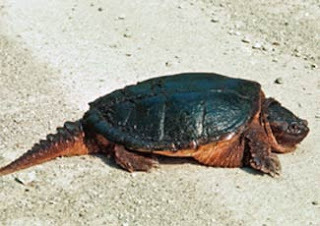
Photo credit: Steven Katovich, USDA Forest Service
Snappers don't make babies until they are fifteen or twenty years old. That's a long time in the animal world and it means that even small numbers of turtle deaths can have a major effect on the species' survival.
Turtles cross roads in search of food, mates or to find a nesting area. They often get smacked by cars, and unbelievably, some drivers run them over just to hear the crunch. If you see a snapping turtle crossing a road, don't try to move it because they bite, hard enough to take off a finger. (They rarely bite in the water, so it's safe to share the swimming spot with them).
Snappers now are a special concern under both Ontario and federal endangered species laws. However, in yet another of the great mysteries of bureaucracy, snapping turtles are still hunted in Ontario. Turtle hunting is open in most parts of the province to residents and non-residents. Each hunter is allowed to take two snappers a day, with a possession limit of five. Endangered species list. Hunting. Duh.
Turtle poaching also is a problem. In some cultures, turtles are valued as food and medicine.
Let's give them a break (brake) folks. There are too many extinct species already.

Photo credit: Steven Katovich, USDA Forest Service
Snappers don't make babies until they are fifteen or twenty years old. That's a long time in the animal world and it means that even small numbers of turtle deaths can have a major effect on the species' survival.
Turtles cross roads in search of food, mates or to find a nesting area. They often get smacked by cars, and unbelievably, some drivers run them over just to hear the crunch. If you see a snapping turtle crossing a road, don't try to move it because they bite, hard enough to take off a finger. (They rarely bite in the water, so it's safe to share the swimming spot with them).
Snappers now are a special concern under both Ontario and federal endangered species laws. However, in yet another of the great mysteries of bureaucracy, snapping turtles are still hunted in Ontario. Turtle hunting is open in most parts of the province to residents and non-residents. Each hunter is allowed to take two snappers a day, with a possession limit of five. Endangered species list. Hunting. Duh.
Turtle poaching also is a problem. In some cultures, turtles are valued as food and medicine.
Let's give them a break (brake) folks. There are too many extinct species already.
Published on August 11, 2011 18:37
August 7, 2011
Enjoying the Heat, but not the Deer Flies
Deer flies normally are just a July annoyance. This year they were a July nightmare that is continuing into August. You can't walk in the woods without dozens of them swarming your head.
The really bad news is that repellents, including DEET, do little to stop them. They are attracted to dark, moving shapes and typically go straight for the head and neck in search of blood. They are among the fastest fliers in the insect world, so there's no point trying to run from them. Photo credit: Howard Russell, MSU Diagnostic
Photo credit: Howard Russell, MSU Diagnostic
Services.
Aside from a full head net, the best protection is a ball cap, which keeps them off your head. Also, you can buy sticky patches for the back of the ball cap. These trap the pests as they dive bomb your head, and they actually work.
They deliver painful bites and drive us crazy with their relentless buzzing about the head, but deer flies actually are pretty if you get one to sit still for a few seconds. They are the size of a house fly, have brilliant striped gold-green eyes and delta wings marked with dark patterns.
They are related to horse flies, which are larger, even more persistent, but fewer in numbers.
Wind and cooler temperatures reduce their activity, but hot days are expected to continue through most of August in many parts of the continent.
The really bad news is that repellents, including DEET, do little to stop them. They are attracted to dark, moving shapes and typically go straight for the head and neck in search of blood. They are among the fastest fliers in the insect world, so there's no point trying to run from them.
 Photo credit: Howard Russell, MSU Diagnostic
Photo credit: Howard Russell, MSU Diagnostic Services.
Aside from a full head net, the best protection is a ball cap, which keeps them off your head. Also, you can buy sticky patches for the back of the ball cap. These trap the pests as they dive bomb your head, and they actually work.
They deliver painful bites and drive us crazy with their relentless buzzing about the head, but deer flies actually are pretty if you get one to sit still for a few seconds. They are the size of a house fly, have brilliant striped gold-green eyes and delta wings marked with dark patterns.
They are related to horse flies, which are larger, even more persistent, but fewer in numbers.
Wind and cooler temperatures reduce their activity, but hot days are expected to continue through most of August in many parts of the continent.
Published on August 07, 2011 19:21
August 1, 2011
Reflections on a Train Wreck
Whenever I think about these sad times in traditional journalism I picture a train wreck. A quick peek at the wreckage scene:The Sun newspaper conglomerate has withdrawn from the National Newspaper Awards, Canadian Newspaper Association, The Canadian Press news agency, and now the Ontario Press Council. Despite whatever group spokespeople say, it's all about saving money to boost bottom lines. Read more at: Honderich: Sad time for newspapering in Ontario - thestar.comThose are some of the same actions Conrad Black and David Radler took in running their newspaper empire in Canada, Britain, Israel and the United States. Their empire disintegrated. Rupert Murdoch, King of Kings in world tabloid journalism, is in so much trouble over the British phone hacking scandal that he might as well bend over and kiss his butt goodbye.There no longer is a national news service delivering news to all media outlets throughout Canada. Co-operative news gathering, mainly for the benefit of the people in our far-flung country, no longer exists. News in Canada now is tribal controlled, much like Afghanistan.What little remained of radio news is being further diminished by electronic networking.Television news continues to transform itself into just another entertainment manipulated for ratings. CBC's The National has become a disgrace in the eyes of many serious, experienced journalists. One, Tim Knight, writes: "Simply put, the senior executives responsible for The National have gone rotten, abandoned the organization's mandate and, in their frantic race for ratings, lost their journalistic focus and with it their journalistic integrity." He calls main news reader Peter Mansbridge "A patronizing chief-anchor-for-life who . . . almost never actually seems to feel the scenes he describes. . . . doesn't care what's in the stories, doesn't see the scenes, doesn't feel the emotions. Has no genuine human response. As a result, of course, neither does the viewer." Read more at: "The day I finally lost all respect for The National" | J-source.ca
Published on August 01, 2011 20:13
July 24, 2011
The Empty Rain Barrel
 I wish I could take it to AfricaThe thermometer reads 35C in the shade as I drain the last drops from the rain barrel. Without water the vegetable garden on my bush lot will wither and die. There is but one thing to do: Load the pickup truck with buckets and start hauling water from our cottage lake to refill the rain barrel.As I lift buckets from the truck bed and pour the water into the barrel, my mind is replaying the news clips I've seen this week about the drought in the Horn of Africa. Cadaverous children with sunken cheeks and huge eyes. Adults barely able to keep mobile as they travel to find water and food. They remind me of the forest animals I see continually foraging to stay alive. But these are humans, and they should not die because of lack of water. The little children with their bones pressing outward against their shrinking skins deserve to grow and experience the wonders of life the same way we have.I see the news show gurus intoning the sad facts of the tragedy, then moving on to the next story. I want to scream: "get off your millionaire's ass and tell viewers why it has become so difficult to get directly to these people the life-saving things they need."Our society is less and less able to act effectively on anything. Individual initiative is smothered by political correctness, stupefying bureaucracy, an over-thinking justice system and, of course corruption and greed for money and power. All any individual can do is write a cheque, most of which will end up in some bureaucrat's pay or pension envelope, or in the pockets of corrupt politicians or warlords.I wish I could fill my rain barrel, load it and a million like it onto planes, and fly them into the deserts where people are dying. Why can't it be that simple? There is water. There are planes. There are flat places to land. Is there no new, daring thinking on how to stop needless deaths?I can fill my rain barrel and save my insignificant little vegetable garden. Millions of us, however, can't find an uncomplicated way to fill rain barrels that will save humans.
I wish I could take it to AfricaThe thermometer reads 35C in the shade as I drain the last drops from the rain barrel. Without water the vegetable garden on my bush lot will wither and die. There is but one thing to do: Load the pickup truck with buckets and start hauling water from our cottage lake to refill the rain barrel.As I lift buckets from the truck bed and pour the water into the barrel, my mind is replaying the news clips I've seen this week about the drought in the Horn of Africa. Cadaverous children with sunken cheeks and huge eyes. Adults barely able to keep mobile as they travel to find water and food. They remind me of the forest animals I see continually foraging to stay alive. But these are humans, and they should not die because of lack of water. The little children with their bones pressing outward against their shrinking skins deserve to grow and experience the wonders of life the same way we have.I see the news show gurus intoning the sad facts of the tragedy, then moving on to the next story. I want to scream: "get off your millionaire's ass and tell viewers why it has become so difficult to get directly to these people the life-saving things they need."Our society is less and less able to act effectively on anything. Individual initiative is smothered by political correctness, stupefying bureaucracy, an over-thinking justice system and, of course corruption and greed for money and power. All any individual can do is write a cheque, most of which will end up in some bureaucrat's pay or pension envelope, or in the pockets of corrupt politicians or warlords.I wish I could fill my rain barrel, load it and a million like it onto planes, and fly them into the deserts where people are dying. Why can't it be that simple? There is water. There are planes. There are flat places to land. Is there no new, daring thinking on how to stop needless deaths?I can fill my rain barrel and save my insignificant little vegetable garden. Millions of us, however, can't find an uncomplicated way to fill rain barrels that will save humans.
Published on July 24, 2011 19:15
July 21, 2011
Incredible, but true
 The four most incredible pieces of information from Rupert Murdoch's News of the World scandal:1. British Prime Minister David Cameron met 26 times with Rupert Murdoch, or his News Corp. executives, in just over one year in power. In addition, he had Murdoch's son James, senior executive Rebekah Brooks, and former editor Andy Coulson (who he later hired for his own staff) as guests to his country home. Does the Pope talk that often with God?2. Ms. Brooks became editor of the News of the World at age 31. The paper was the largest circulation English language newspaper in the world. She appears to have had no formal education beyond high school. She joined the News of the World as a secretary at age 21. She later started writing about TV soap operas and at 29, less than three years before becoming the newspaper's boss, she was just a feature writer, but a charming and vicious networker. In getting ahead, who you know really is more important than what you know.3. Rupert, looking owlishly arrogant, told a British parliamentary committee he is not to blame for the phone hacking or other outrages committed by his news empire. Employees he trusted are to blame. Rupert, Rupert, Rupert, you nasty little worm. You hired them. You created the culture of power craving and greed in which they thrived.4. In a world of possible terrorism on every street corner, a man with a shaving cream pie gets past British security, into a parliamentary hearing room and at Rupert Murdoch. How safe does that make the world feel? And, we still have to take off our shoes when we enter an airport lineup.
The four most incredible pieces of information from Rupert Murdoch's News of the World scandal:1. British Prime Minister David Cameron met 26 times with Rupert Murdoch, or his News Corp. executives, in just over one year in power. In addition, he had Murdoch's son James, senior executive Rebekah Brooks, and former editor Andy Coulson (who he later hired for his own staff) as guests to his country home. Does the Pope talk that often with God?2. Ms. Brooks became editor of the News of the World at age 31. The paper was the largest circulation English language newspaper in the world. She appears to have had no formal education beyond high school. She joined the News of the World as a secretary at age 21. She later started writing about TV soap operas and at 29, less than three years before becoming the newspaper's boss, she was just a feature writer, but a charming and vicious networker. In getting ahead, who you know really is more important than what you know.3. Rupert, looking owlishly arrogant, told a British parliamentary committee he is not to blame for the phone hacking or other outrages committed by his news empire. Employees he trusted are to blame. Rupert, Rupert, Rupert, you nasty little worm. You hired them. You created the culture of power craving and greed in which they thrived.4. In a world of possible terrorism on every street corner, a man with a shaving cream pie gets past British security, into a parliamentary hearing room and at Rupert Murdoch. How safe does that make the world feel? And, we still have to take off our shoes when we enter an airport lineup.
Published on July 21, 2011 05:35
July 17, 2011
Getting Silly over 1812
Hey Canada, pull out the worry beads.
We appear to be fretting ourselves into a funk over a major celebration of our history. As usual, the fretting is connected to our incurable inferiority complex.
The Toronto Globe and Mail has published a hand-wringing piece about how the federal government will "tread carefully" in celebrating the 200th anniversary of the War of 1812-14 to avoid "inciting anti-American sentiment."
Ottawa will be very careful, the Globe reported, not to upset the Americans with boasts of how we repelled the U.S. invaders roughly 10 generations ago. It said the government is carefully crafting its messages about the bicentennial to stress how we have lived peacefully with our most important neighbour and trading partner ever since.
The paper even had eminent historian Jack Granatstein predicting that sparks will fly across the border as the bicentennial approaches.
The fear is that bicentennial celebrations will spawn Canadian cockiness and anti-Americanism that will inflame sensitivities south of the border.
Oh dear, we Canadians do know how to haunt a party.
Firstly, the Americans, plenty busy with their own current problems, likely don't care how we feel about the War of 1812 or how we celebrate its anniversary. To them, that war was basically another fight against the hated British.
The Americans haven't held a grudge about this before, so it's hard to see why they would two centuries after it ended. In fact, they have done more to celebrate one hero of the British-Canada side than we have. That would be Tecumseh, the Shawnee chief who left Ohio Territory to fight on our side because the Yanks kept stealing Indian lands.
[image error] Kids in the States have been named after him, including the Civil War general William Tecumseh Sherman. Midshipmen at the U.S. Naval Academy at Annapolis, Maryland offer prayers and pennies to a statue named Tecumseh in the hope that he will bring them good luck in exams and sporting contests. A scene of his death at the Battle of the Thames is painted high atop the Rotunda of the U.S. Capitol.
So Canada, let's take a few really deep breaths, a couple of teaspoons of perspective, and have some fun celebrating history shared by both countries. After all, the War of 1812 ended in a draw. Let's keep it that way.
(If you want to know more about Tecumseh and the War of 1812, see my book 'Tecumseh: Shooting Star, Crouching Panther' Dundurn Press 2009)
We appear to be fretting ourselves into a funk over a major celebration of our history. As usual, the fretting is connected to our incurable inferiority complex.
The Toronto Globe and Mail has published a hand-wringing piece about how the federal government will "tread carefully" in celebrating the 200th anniversary of the War of 1812-14 to avoid "inciting anti-American sentiment."
Ottawa will be very careful, the Globe reported, not to upset the Americans with boasts of how we repelled the U.S. invaders roughly 10 generations ago. It said the government is carefully crafting its messages about the bicentennial to stress how we have lived peacefully with our most important neighbour and trading partner ever since.
The paper even had eminent historian Jack Granatstein predicting that sparks will fly across the border as the bicentennial approaches.
The fear is that bicentennial celebrations will spawn Canadian cockiness and anti-Americanism that will inflame sensitivities south of the border.
Oh dear, we Canadians do know how to haunt a party.
Firstly, the Americans, plenty busy with their own current problems, likely don't care how we feel about the War of 1812 or how we celebrate its anniversary. To them, that war was basically another fight against the hated British.
The Americans haven't held a grudge about this before, so it's hard to see why they would two centuries after it ended. In fact, they have done more to celebrate one hero of the British-Canada side than we have. That would be Tecumseh, the Shawnee chief who left Ohio Territory to fight on our side because the Yanks kept stealing Indian lands.
[image error] Kids in the States have been named after him, including the Civil War general William Tecumseh Sherman. Midshipmen at the U.S. Naval Academy at Annapolis, Maryland offer prayers and pennies to a statue named Tecumseh in the hope that he will bring them good luck in exams and sporting contests. A scene of his death at the Battle of the Thames is painted high atop the Rotunda of the U.S. Capitol.
So Canada, let's take a few really deep breaths, a couple of teaspoons of perspective, and have some fun celebrating history shared by both countries. After all, the War of 1812 ended in a draw. Let's keep it that way.
(If you want to know more about Tecumseh and the War of 1812, see my book 'Tecumseh: Shooting Star, Crouching Panther' Dundurn Press 2009)
Published on July 17, 2011 19:40
July 12, 2011
Kids Without Homes
[image error]
I recently got an understanding of why our government, and the Bank of Canada, continue to issue warnings about personal debt levels. I got this from watching a CBS 60 Minutes segment. The CBS piece was about family homelessness; interviews with decent, average families who lost their homes and found themselves living in their vehicles, parks or cheap motels. CBS reported that 14 million American children were in poverty before the recent great recession. That's now 16 million, up two million in two years. In Florida's Seminole County schools, 1,000 students have lost their homes. One educator running programs for homeless kids in Seminole County said between five and 15 new homeless kids join her programs every day. On Highway 192, the road to Disney World near Orlando, 67 motels house 500 homeless kids and their families. Special school bus runs have been organized to pick up these kids and take them to and from school.The children interviewed on camera are nice, well-spoken kids being raised by decent parents who have lost their jobs, and their mortgaged homes.Some of the interviews are heartbreaking. Said one student: "I kind of feel like it's my fault that we don't have enough money. I feel like it's my fault that they (my parents) have to pay for me. And the clothes that they buy for me."The Certified General Accountants Association of Canada said recently that
the pace of debt accumulation in Canada is declining but household debt levels still soared to a new record of $1.5-trillion in the first quarter of 2011, leaving many Canadians with lower or stagnant incomes in a "dire" situation. The association reported that more than half of indebted Canadians are borrowing money just to meet their day-to-day living expenses.Bank of Canada governor Mark Carney has warned in the past of the impact of rising Canadian debt levels, and in a separate report recently, TD Economics warned that "following five years of excessive debt accumulation, Canadian households are finally tapped out."The great fear is that when interest rates begin to rise, many Canadians will not be able to meet increased monthly payments.After watching the kids on 60 Minutes, we don't want to see that happen here.You can view the 60 Minutes homeless segment at: http://www.cbsnews.com/video/watch/?id=7371392n
the pace of debt accumulation in Canada is declining but household debt levels still soared to a new record of $1.5-trillion in the first quarter of 2011, leaving many Canadians with lower or stagnant incomes in a "dire" situation. The association reported that more than half of indebted Canadians are borrowing money just to meet their day-to-day living expenses.Bank of Canada governor Mark Carney has warned in the past of the impact of rising Canadian debt levels, and in a separate report recently, TD Economics warned that "following five years of excessive debt accumulation, Canadian households are finally tapped out."The great fear is that when interest rates begin to rise, many Canadians will not be able to meet increased monthly payments.After watching the kids on 60 Minutes, we don't want to see that happen here.You can view the 60 Minutes homeless segment at: http://www.cbsnews.com/video/watch/?id=7371392n
Published on July 12, 2011 19:22



